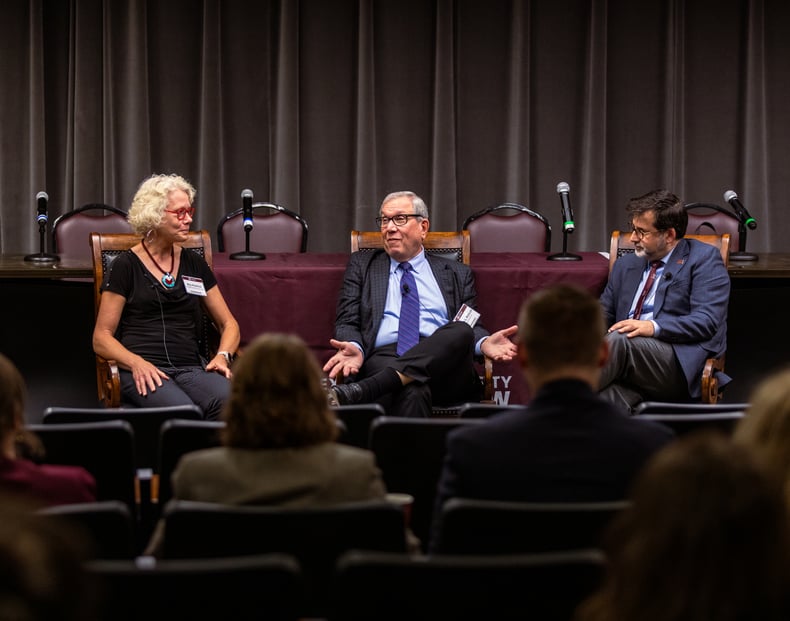
On Friday, September 29, the Texas A&M Law Review hosted various scholars at its Fall Symposium titled, “More Than Sports: What Comes After NIL?”
The symposium began with a Keynote Fireside Chat with Jeffrey Kessler, Partner, Co-Executive Chairman & Co-Chair, Antitrust/Competition Practice, Winston & Strawn LLP, regarding Alston v. NCAA and its impacts on the future of NIL in college athletics. After the keynote with Kessler, three different panels discussed “Antitrust and Employment Law Implications,” “Collectives and Federal Action,” and “The Effect on Athletes.”
Kessler started out by analogizing NIL in college sports to free agency in the NFL. Kessler argued that the same concerns that free agency would “ruin the sport” are reiterated with NIL, but that such concerns are misplaced as “we see sports getting bigger and more valuable as restrictions get loosened.” The concept of amateur sports no longer holds any weight, as the true value in the sports “is that athletes are students at the school.” Rules requiring the athletes to remain students at the school are not under attack, only that the students be fairly compensated for the revenue they produce for their universities.
The panelists for the “Antitrust and Employment Law Implications,” Professors Michael A. Carrier, Matthew Mitten, and Roberto Corrada, shared their thoughts regarding how Alston will begin to impact antitrust and employment law in college sports. Professor Carrier raised concerns about antitrust claims moving towards conferences as they continue to grow and increase market control, where any NIL restrictions (specifically on the state level) would trigger antitrust claims. Professor Mitten argued that a federal solution has the best potential to resolve concerns of the antitrust claims; whereas Professor Corrada believed that collective bargaining was the best solution since it would grant antitrust immunity and avoid lengthy litigation to get answers immediately. No clear solution appears to resolve all the issues presented to college athletes with NIL deals, but at least some solution is required to provide much-needed guidance.
The second panel consisted of panelists Kevin McDonald ’89, Professor Jodi Balsam, and Professor Bruce Green to discuss “Collectives and Federal Action.” McDonald began by explaining the purpose of collectives before the panel moved towards whether regulation over such organizations was necessary. Professor Balsam argued for treating athletes just like any other students on various campuses and rely on pre-existing state laws regarding publicity rights. Professor Green, however, focused more on the ethical implications with regulations, as institutes of higher education that are meant to be ethical exemplars may be regularly breaking regulations with impunity. Professor Green argued that if we are to create regulation, there needs to be strong enforcement because people will ultimately break the rules. McDonald reiterated Professor Green’s concerns as the NCAA has struggled enforcing its rules against collectives. Ultimately, any regulation that is adopted requires strong enforcement to be effective but how extensive that regulation should be is still yet to be decided.
The final panel consisted of Professor Maureen Weston, Professor Tan Boston, and Gary Way to discuss “The Effect on Athletes.” Professor Weston focused primarily on the concern for more comprehensive education offered by schools to help students avoid predatory deals that we have seen popping up. While there is currently no reporting system for these deals, Professor Weston emphasized the need for schools to have comprehensive NIL education programs so that their students can make informed decisions when entering such deals. Professor Boston added to this educational concern by raising Title IX worries as schools become more involved in NIL deals with students. While the majority of students are entering agreements that earn them revenue in the hundreds of dollars, if schools begin taking active involvement in NIL deals, they will need to ensure that such benefits and services are equal or equal in effect to comply with Title IX. Way emphasized just how crucial these NIL deals are to the mental and physical well-being of athletes, as many college athletes are first-generation college students who may be suffering from food insecurity. Furthermore, the education offered by universities accelerates students’ learning of personal finance and business skills that they otherwise would not have, but there are still concerns about how this income will impact their financial aid and tax liability.
The new world of NIL regulation still leaves a lot of questions to be answered, and these questions need to be answered as soon as possible. No one perfect solution exists, but college students need answers now in order to make informed decisions.
Texas A&M Law Review would like to thank all the panelists and moderators for their hard work and participation in the symposium.